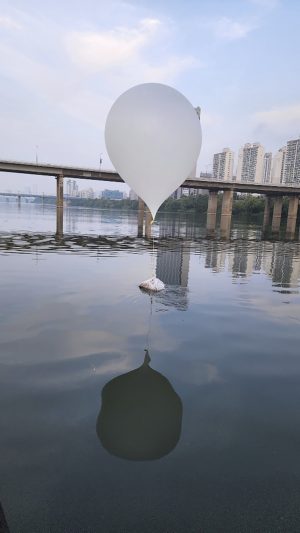North Korea has been flying substantial numbers of “trash balloons” over to South Korea. Cell phones sound alerts in the middle of the night whenever these balloons cross over into South Korea. The balloons, which often contain animal waste, have caused quite extensive damage, such as breaking vinyl greenhouses and hitting private cars.
Although confrontations between North and South Korea are usually triggered by North Korea, on this occasion the issue began with the South Koreans.
For many years, South Korean civil groups have been tying USBs containing leaflets criticizing the Kim Jong Un administration, along with South Korean movies, TV series, and K-pop to balloons that are then dispatched northward. The practice has been an irritation for Pyongyang. Leaflets denigrating the Supreme Leader are not only considered outrageous in North Korea, but the North Koreans are also nervous about the influx of South Korean culture, as evidenced in the enactment of the “Law on Rejecting Reactionary Ideology and Culture” in December 2020 and the “Pyongyang Cultural Language Protection Act” in January 2023.
Their patience having run thin, the North Koreans issued a statement in the name of the vice defense minister on May 25, threatening to fly balloons to South Korea. The statement expressed strong concern about “how much effort is required to remove them,” meaning the flying objects from the south, and said that the flying balloons were “a dangerous provocation that can be utilized for a specific military purpose.” With this, Pyongyang is suggesting that balloons can be used as biochemical weapons; as such, its anger is understandable.
Nonetheless, South Korea did not end the practice, and three days later, North Korea began sending balloons toward South Korea, carrying cigarette butts, old batteries, and even excrement. Obviously, Pyongyang concluded that flying leaflets praising Kim Jong Un would have little effect on the South Korean people.
On May 29, Kim Yo Jong, vice department director of the Central Committee of the Workers’ Party of Korea (WPK), jokingly referred to the “trash balloons” as “sincere presents” and criticized South Korea for holding that the leaflet distribution falls under “freedom of expression.” On June 2, the vice defense minister issued another statement unilaterally declaring that this action would be “temporarily halted,” but warned that if the South Korean side resumed distributing leaflets, they would “again dump 100 times more trash.”
The Yoon Suk-yeol administration did not urge South Koreans to exercise restraint, and after a group of North Korean defectors dispatched leaflets toward North Korea on the 6th, the North Koreans began to fly “trash balloons” again on the 8th, although the volume was some way short of “100 times more.” Clearly, it takes some time to prepare such a large number of big balloons.
On the 9th, Kim Yo Jong released another statement, the last sentence revealing her true sentiment. Rather than threatening specific acts of retaliation, it concluded by saying, “I sternly warn Seoul to stop at once this dangerous act that may create a new environment of crisis.” It is quite clear that North Korea only wants to stop the balloons from South Korea, hoping to avoid escalating the issue more than necessary. As further evidence of this, the Rodong Sinmun has not reported on this move to the domestic readership.
North Korea also condemned the balloons from South Korea in June 2020. Back then, it used the practice as an excuse to blow up the Inter-Korean Liaison Office, a symbol of inter-Korean cooperation, and informed the North Korean people in detail about the deterioration of relations with South Korea.
In December 2020, South Korea – then under the Moon Jae-in administration, whose goal was peaceful coexistence with North Korea – enacted the “Law Prohibiting the Sending of Leaflets to North Korea,” which imposed a penalty of up to three years in prison for distributing leaflets. However, in May 2022, to the hardline conservative Yoon Suk-yeol administration took over, and in September 2023, the Constitutional Court ruled the law unconstitutional as it “excessively restricts freedom of expression.”
Retaliating against the “trash balloons,” the South Korean government decided to suspend the Comprehensive Military Agreement (CMA), which had been signed in September 2018, on June 4. Likely the intention was to send a strong message to North Korea, but in reality, this was a significant loss for South Korea as well. Under the agreement, North Korea had made concessions to South Korea, such as acknowledging the existence of the Northern Limit Line (NLL) for the first time. It is not a good idea for South Korea to let go of this framework in an attempt to regulate North Korea’s actions. President Yoon Suk-yeol voluntarily gave up this card just so that he could reject his predecessor’s policy toward North Korea.
Under the assumption that the balloons carry not leaflets or excrement but biochemical weapons, both South and North Korea are on high alert. Unlike ballistic missiles, balloons can be flown at low altitudes in large numbers simultaneously, so there are natural limits to the available countermeasures. With this issue unlikely to end any time soon, it will surely not be long before “trash balloons” that fall into the sea wash up on the coasts of Korean neighbors such as Japan.
ISOZAKI Atsuhito is a professor at Keio University.

































